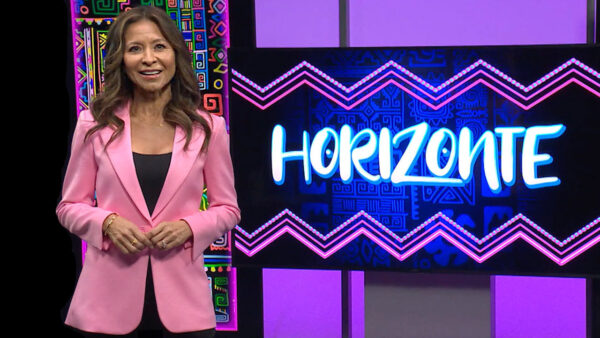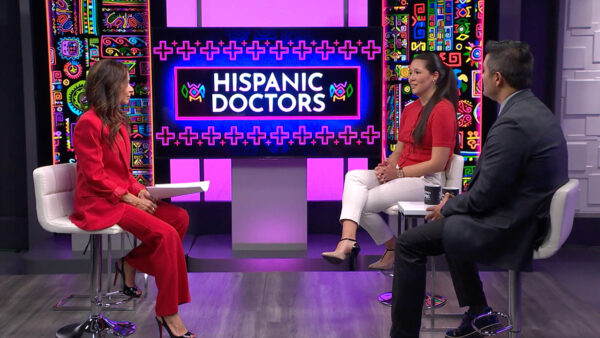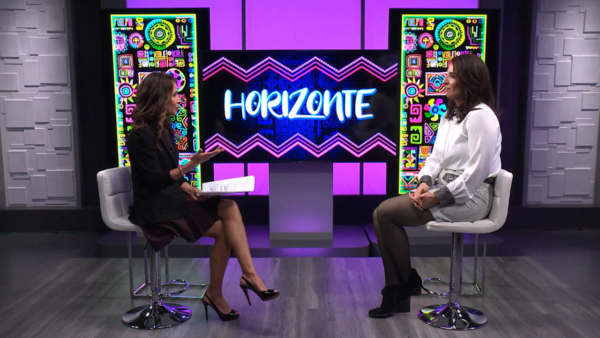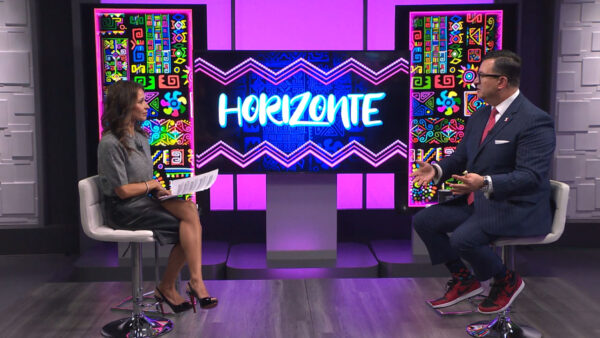The Arizona School Administrators Association is asking for an additional $300 million a year in order to implement the English Language Learner (ELL) education requirements mandated by the Legislature in a law passed in 2006. Dr. Greg Wyman, Apache Junction Unified School District Superintendent and President of the Arizona School Administrators, and Mike Martinez, Cartwright School District Superintendent and President of the Arizona Hispanic School Administrators Association, tell us about their concerns if ELLs are not adequately funded by the state.
Richard Ruelas:
Welcome to "Horizonte." Good evening. I'm Richard Ruelas. Jose Cardenas has the night off. State educators say they need more funding to educate English language learners. And helping parents learn about the early signs of autism in children coming up next on "Horizonte."
Announcer:
Funding for "Horizonte" is provided by S.R.P.
Announcer:
S.R.P.'s business is delivering water and power but our dedication to the community doesn't stop there. S.R.P. - delivering more than power.
Richard Ruelas:
Superintendents from across the state met at the capital last week to push for an additional $300 million to educate English language learners. The concern is the cost to implement a 2000 law passed by the legislature designed to put Arizona in compliance with a court case filed in 1992, Flores versus Arizona, which found Arizona schools not providing adequate English instruction. Joining me to talk about concerns and impact if E.L.L. isn't adequately funded is Dr. Greg Wyman, Apache Junction Unified School District Superintendent and President of Arizona School Administrators Association. And Mike Martinez, Cartwright School District Superintendent and President of the Arizona Hispanic School Administrators Association.
Richard Ruelas:
Gentlemen, good evening. Thanks for joining me.
Greg Wyman & Mike Martinez:
Thank you.
Richard Ruelas:
We will start with you, $300 million, where does that figure come from?
Greg Wyman:
School districts from across the state of Arizona, figuring out how to implement the E.L.L. task force recommendations. They came in with a set of task force recommendations in late fall. Those are based on the law that was established by the state legislature, and there was a standardized form that was used across the state by school districts, and in compliance with the law, how many teachers do you need? How much classroom space do you need --
Richard Ruelas:
Based on a model, even though this issue has been around a while, it was just in the fall that the state developed a model that they wanted schools to follow?
Greg Wyman:
The state, legislators passed a law last spring. A task force, come up with a set of models, school districts could choose to use and implement by next September. Those models were released approximately October, November, and now school districts are trying to come up with what is that funding source.
Richard Ruelas:
So you sent out a survey to your districts asking essentially what -- fill in these boxes, what would it take now?
Greg Wyman:
How many teachers, how much classroom space, and the reason we want that number out because this is the legislative program. So we understand the number is fairly large and we want to make sure that they are understanding of that number as they go to solve their own budget crisis. We believe that the numbers that we're going to be presented to the Arizona department of education later in the month have inherent flaws and that the number was going to come in significantly lower than what it is truly going to cost us to educate these children.
Richard Ruelas:
Mr. Martinez, Superintendent Horne was on "Horizon." He talked about his own numbers. Also described sort of there shouldn't be much cost to the state if students who need this instruction can be shuffled between classrooms, split, using the same current teachers in each school to teach E.L.L. to those kids who need it. I don't know if you heard his comments, but did that model work for you?
Mike Martinez:
For our school district it is considerably easier, the majority of our population happens to be an English language learners population. When you are looking at 50% of our population being English language learner, we have 9,000 English language learners, 2,000 above that number are considered fully English proficient. With those types of numbers you can make better adjustments with regard to the task force model. I qualify that by saying, we start separating students by proficiency, the emergent, pre-emergent, basic, intermediate --
Richard Ruelas:
That's required by state law.
Mike Martinez:
Required by state law that the students be taught. There are requirements. Kindergarten cannot be grouped with other grades. That is stand-alone situation. So for school districts with lower numbers, facing a process trying to implement a program separating the children out by proficiency, and even though you have five teachers, you may need a sixth because you are moving students into that separated proficiency level, and in doing so you may need another staff member to handle that. It is not taking the same number of teachers and divided it into the total number of kids, because you are separating the population, within the 80 kids, 20 who are perhaps emergent, or pre-emergent, you may need to deal with them. If all of the numbers worked out, you may not need another teacher. If they do not, you are looking at adding staffing.
Richard Ruelas:
Superintendent Horne, a significant gap between what he expects E.L.L. to cost and what your study shows. How do you explain that gap?
Greg Wyman:
There are two major points we would have contentions with. The first one is what is called offsets. If I currently am receiving $500 from the federal government to teach these kids, and I've gone ahead and done the math on this program and it is now an additional thousand dollars that says I should get $1,500 to teach these kids. What Superintendent Horne and the Arizona department of education, no, you have to back out and offset $500 that you're already getting, you should get $1,000. The judge in Tucson has ruled that that is illegal. Supplanting, you can't supplant federal dollars. Their forms do not account for additional classroom space that might be needed in some of the scenarios that Mike just explained. We have to by this task force recommendation, pull these children out for four hours of education. You are going to have to place them somewhere. If you do not have another space -- we are talking about a four hour block of time with these children. It does become prohibitive for any number of school districts that don't have the classroom space currently.
Richard Ruelas:
All of the student who need the instruction, put them in one classroom, the law dictates you have to put them depending on their proficiency level.
Greg Wyman:
Proficiency level and grade level. Kindergarten kids by themselves, first through third, fourth, fifth, proficiency levels. You can see, you start dividing up a lot of different ways. You have to have teachers there. Mr. Horne's number to me earlier were 900 teachers. It is a significant amount of teachers we are going to have to find to teach the classes and we are going to have to put them somewhere.
Richard Ruelas:
Bring up the supplanting of federal funds, part of the issues in the court case which is long running and gets very complicated, but as a superintendent, how difficult is it to even plan your budget without knowing how these issues are going to play out? How do you do it year by year in dealing with E.L.L. students?
Mike Martinez:
Quite simply we know that A.D.D., and the state legislature, majority party, believe the federal funds are there for that purpose. In essence we've always had that funding. Arguably from their perspective that may work. From our perspective, and at least three cost studies, one which was actually requested by the legislature, and the number, even the dollar number that was provided back then, when you account for inflation, that makes our number not an unreasonable number, especially if you comply with what the judge has said and which we already know in preparing budgets, you cannot use federal funds to supplant what is the state's obligation to provide for education for its children. You supplement, but you don't supplant. The state department and the legislature believe that that federal funding has always been there. For those of us, it would be business as usual. Now throw in the task force model which requires that proficiency grouping, which has class size recommendations, then you are looking at a host of scenarios that are just not in our present kit of tools.
Richard Ruelas:
Every district sort of has made do in what has been given to them. Under these models you must follow, it probably is going to cost districts more money even if they think they are doing an adequate job.
Mike Martinez:
Absolutely.
Greg Wyman:
I think the concern is the huge discrepancy between what we're currently receiving and any number of the cost studies that we talked about. Our number is $2,741 per child. Currently getting $365 a child. There is a huge discrepancy there, and to -- every cost study has put it above a thousand dollars. There isn't a cost study that says anything near $300 is going to do the job. We're just saying look, we will comply. Please fund it.
Richard Ruelas:
If the state lawmakers do not give you that gap, what are you -- where do you find the money or do you just not comply with the new state law and do what you're doing now?
Greg Wyman:
That's the difficulty. The law is very specific, if we do not comply, sanctions and corrective action, and ironically that would be to take money away from us. So it's really a catch-22 for us. We will do the best we can to comply. We're here for kids and we're here to teach kids, but we do need to have adequate resources to teach all children and that's all we're asking for.
Richard Ruelas:
You had the news conference this week. What kind of feedback did you get from lawmakers about your number?
Mike Martinez:
I would have to say that the feedback that we received is what we expected. It does fall along party lines in this case. The Latino caucus, I met with them, and they were very receptive that this is not new news to them. Surprisingly, many of the other legislators from the other districts, they were -- they received feedback that actually was receptive, at least to the idea that it may be a heck of a lot more than the money that we're presently funding, and keep in mind that March 4th date that the legislature that is to provide --
Richard Ruelas:
If the lawmakers don't provide it, a judge may make them provide it. Thank you for joining us in this discussion.
Mike Martinez & Greg Wyman:
Thank you.
Richard Ruelas:
The centers for disease control estimates that one out of 150 children will be diagnosed with autism. It's a developmental disability that can be treated, but not cured. Early detection greatly helps a child's success with the condition, but as Marcos Najera reports, the southwest autism research and resource center here in the valley is concerned that Latino families might be waiting too long to find help.
Marcos Najera:
This is a six-year-old Arturin Obeso a few months ago, this is his first visit to SARRC, the Southwest Autism Research and Resource Center.
Eriko Obeso:
Good job.
Marcos Najera:
This is Arturin now. Since he was born, his mom noticed something different about him.
Marcos Najera:
As the years passed, it was clear that he couldn't talk and he was often frustrated. So was his family. But a mix of tight budgets, fear, and confusion, kept his parents from finding the help the little boy needed.
Rachel McIntosh:
Grieving for your child that you thought that this person that you thought you may have and grow up and maybe won't -- won't match that picture in your head you had when they were an infant. He received a diagnosis when he was two. He didn't have a new diagnosis. They were trying to navigate the system and figure out what services in Arizona they could access.
Marcos Najera:
Behavior specialist Rachel McIntosh realized that many Latino families needed better information about autism. She helped launch the Hispanic outreach program at SARRC. The cornerstone of the program is called Jump Start. It is a five week early intervention program that teaches parents how to raise a child with special needs. Just like this child who started hitting himself because he couldn't talk.
Rachel McIntosh:
He was making the disruptive behaviors work for him. If you don't understand the social world, if you don't understand how to use communication effectively, it is pretty effective to hit yourself and bang your head on the wall, right? If you see someone hit them really hard, you stop and pay attention to them. He is trying to communicate -- he wants to leave here. Or, you know, where am I right now? And he didn't have a way. He didn't have words to tell us that and ask, hey, what are we going to do next? And so in his mind, the next time he wants to get your attention or mom's attention, what is he going to do? He is going to hit himself, that makes perfect sense. That is when mom comes running over to me and starts offering me things. That had been working for him for six years. So we had to give him a way to communicate.
Marcos Najera:
Experts often describe having autism as being trapped in a foreign country without knowing the language or being forced to know the rules of a difficult game that you've never played. Here we see him learning new ways to communicate. He uses simple toys and flash cards. His mom noticed an immediate difference.
Julio Ramirez:
One thing, you know -- you have this problem, so you can love him more. That's what I tell him. A child with little problems, because god wants you to love this child more than you would love any other child.
Richard Ruelas:
Here with me from the Southwest Autism Research and Resources Center to talk about the diagnosis of autism among Hispanic children are Diana Diaz Holland, Hispanic Community Relations Specialist, and Dr. Raun Melmed, cofounder and medical director.
Richard Ruelas:
When you started the institute ten years ago, autism wasn't diagnosed in the numbers it is now. What has happened in the last decade?
Raun Melmed:
It was at first co-founded with Denise, and there was certainly a need, but I don't think any of us dreamed the extent of the problem and what would be happening over the next ten years, and certainly not just in Phoenix, but worldwide, an explosion of the number of children being diagnosed. The systems are being taxed. There are many kids out there.
Richard Ruelas:
Is the misdiagnosis that happened a decade ago, and still happens now, due to people not thinking this is a condition?
Raun Melmed:
There are a lot of different reasons for it. Physicians and Psychologists sometimes might have been reluctant to almost sentence some parents to what was considered back then a life sentence, and naturally one can understand, no one wants to be the bearer of bad news. To some extent that was the concern. The most important thing I think there was a lot of ignorance, a lot of individuals that did not in medical school, post-graduate training in psychology, have the experience of learning to identify autism and diagnose it properly. That's one of our missions to make sure that that changes, that the young residents graduating from pediatric programs around the valley and around the state do have that experience and are exposed to that.
Richard Ruelas:
As I watched that video of that child injuring himself and throwing himself against a pillow, I could hear -- is there cultural barriers specific to Latinos that would keep them from seeking a diagnosis or accepting a diagnosis of autism?
Diana Diaz:
There are cultural barriers, the disparity in health care in general, makes it difficult for parents to be proactive and say I don't see my other children doing this. My child seems a little different. If the doctor says, he will grow out of it, Latino parents will say okay, the doctor said he will grow out of it, so he probably will. That's what we all hope for. But to actually obtain an evaluation and a diagnosis, parents need to be very, very proactive. They almost have to demand this of their health care provider, of their insurance, so Latino parents tend not to do this.
Richard Ruelas:
Not a cultural reason, but lack to insurance and medical facilities.
Diana Diaz:
Exactly. When they have state health insurance, it is difficult to get these evaluations approved.
Richard Ruelas:
When you say something we all hope for, your own child has autism?
Diana Diaz:
Yes.
Richard Ruelas:
What was that like for your family? Does your family have a buy-in realizing that your child --
Diana Diaz:
Actually we were told he was probably speech delayed because he was hearing English and Spanish in the home. So I wanted to believe that. And I think we lost a couple of months, and, you know, where we could have gotten an earlier diagnosis and started treatment earlier. We were thinking well, maybe he's just a little behind because we're trying to make him bilingual.
Richard Ruelas:
Do all parents, doctor, feel a reluctance outside of their providers not wanting to sentence them, at least in the old days sentence them, do parents feel a reluctance to accept the diagnosis?
Raun Melmed:
Parents are torn. They know something that is not quite right, but of course they can be concerned about self-fulfilling prophecies. Labels, labels in our society are sticky. They want to try to avoid that at all costs. At the same time the parents of children with autism fight. They want to find answers. They want to find reasons for the problem. They want to know what to do about the problem. They don't always have access to the correct medical information, correct psychological services and educational services around, but there is no doubt in my mind that were those services available equally to all segments of our community, autism would be diagnosed a lot earlier in all of those segments, especially in the minority groups.
Richard Ruelas:
It sounds like a matter of access, is that your understanding dealing with Hispanic parents, not so much not willing to accept it for a cultural reason, but just not being able to get the diagnosis?
Diana Diaz:
I think it is a little of both. Access to health care is a big issue. Also we're taught to keep our problems within ourselves. If we have a child not behaving well, maybe it is because you're not parenting them well. You try to find answers within your own family, and see if there is somebody else in the family who might have spoken later and tried to get answers within your own family instead of seeking out. There are cultural barriers as well as access to health care.
Richard Ruelas:
Right. I guess if access to health care is key, doctor, what can be done to sorts of equalize that across the board?
Raun Melmed:
I think it's education. It's educating the medical students, it's educating the populations out there. It's letting community workers understand what autism is all about. Making sure that information is available in English and Spanish. Making sure that the work is out there that understand Latino community, African American communities, Native American communities, and make sure they can approach those people in a culturally competent fashion and let them know what is needed for their children.
Richard Ruelas:
What are the signs for dealing with Spanish speaking parents of possibly autism children?
Diana Diaz:
Campaign, Spanish media, radio, TV, prints, Spanish materials, lots of interviews. We do almost weekly appearances with Spanish media -- flooded our phone lines from questions from parents who knew there was something wrong with their child but didn't know what the label could be. Since we know media, Spanish media in particular is the first line of knowledge and information for people in the Hispanic monolingual community. That's what we're targeting and it's been very effective.
Richard Ruelas:
Play an advocacy role, help you get along in life kinds of role.
Diana Diaz:
Right. Once parents are equipped with the symptoms and signs of autism, I know the signs of autism, I see them in my child, I would like an evaluation.
Richard Ruelas:
There is state legislation, doctor, you would like to see that deals with health care access?
Raun Melmed:
Right now there has been a bill introduced and hopefully will eventually pass to try and improve the services that insurance companies allow for clients who have children with autism.
Richard Ruelas:
Greatly based on money, how much you pay for coverage --
Raun Melmed:
It is absolutely the case. Either pay now or pay later. Early intervention makes a huge difference. I don't think anyone wants to weigh on their shoulders the weight, denying these children services. 90% of the children with autism in Maricopa County are under the age of 20 years of age. Adult services that will take place in the next decade. It is going to be enormous. The time to start is early. Resources need to be allocated to mak
e sure that that actually happens.
Richard Ruelas: So, is there resistance to taking sort of the handcuffs off providers to treatment centers of what they can do and sort of not letting insurance companies stop --
Raun Melmed
: The few insurance companies that I've spoken to, and the few legislators I've spoken to actually sound relieved that they have been given an opportunity to do the right thing. I have been pleasantly surprised. I have every faith in our legislature here in Arizona. 20 states in the country have done something similar to what we are asking them to do. They want to do the right thing. It is a matter of getting the language together where everybody can agree and everybody is comfortable to make sure that this happens.
Richard Ruelas: Main difference in diagnoses between Latino -- we have no numbers of how many Latino children versus mainstream population, but you were saying that the age of diagnosis is vastly different.
Diana Diaz: The median age in the mainstream population is three, and here in Arizona, largely due to the Latino population, the age is almost six and most of these diagnoses are coming from the schools. A child comes into the school. They're five or six, not speaking, toilet trained, and having major behavioral issues. Someone has to make a diagnosis and it turns out they have autism and they are not seeking services until after age five or six, which is quite tragic, because the window of opportunity between 18 months and three years you can have more success.
Richard Ruelas:
You have been flashing the number of the institute up during the interview. Thank you for coming in.
Richard Ruelas:
Voters in more than 20 states cast their ballots on February 5th, Super Tuesday. An analysis on the results next Thursday on "Horizonte." I'm Richard Ruelas. Thanks for joining us tonight. Have a good evening.
Dr. Greg Wyman: Apache Junction Unified School District Superintendent and President of Arizona School Administrators Association;























